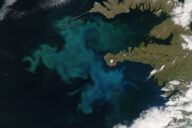VHS virus on the rise in Great Lakes
0
A shad infected with VHS.
Scientists have reported more cases of the detrimental fish virus VHS were uncovered in the Great Lakes last year. However, the associated fish deaths were few in number. VHS, or viral hemorrhagic septicemia, is harmful to fish but not humans, with symptoms that include bleeding, anemia, and quick death.
The devastating virus was discovered in many locations and within a number of fish species in Lakes Superior and Michigan. Paul Bowser, a Cornell Aquatics professor, said specific locations won’t be available until printed in scientific research journals.
While he says the virus is present in the Great Lakes, “[…] it’s important to note that since 2008 and beyond there’s been very few actual mortality events associated with viral hemorrhagic septicemia in the Great Lakes basin.”
He also said careful monitoring of VHS activity in the Great Lakes is necessary to determine the virus’ behavior. VHS research and observation are supported by a variety of agencies, the Great Lakes Protection Fund, Sea Grant, and the U.S. Geological Survey — to name a few. Yet, these bureaus are contending with the possibility of budget cuts, which Bowser said will significantly impact the VHS studies.
Although the virus will not harm people, there is concern about its potential impact to the fishing industry. Steve Dahl, a commercial fisherman in Two Harbors, Minn., and Minnesota North Shore Commercial Fisherman’s Association president, expressed concern that VHS could be catastrophic to fishing profits. He said he and his organization have not encountered infected fish, however.
VHS was discovered in European freshwater trout in the 1930s and still appears in European trout farms. In 1988, the virus initially showed up on the West Coast of the United States in marine trout and salmon. Marine fish near New Brunswick also showed signs of the virus from 2000-2004. In 2005, it was spotted in Great Lakes. It has been noted that the Great Lakes virus strain is more similar to the West Coast strain that the European one.
At this time, there are 28 known species of fish, including 19 sport fish, that have been found to be prone to the Great Lakes variety of the disease. Recent research by Robert Kim and Mohamed Faiscal of Michigan State University probed the predisposition of eight central species of sport fish to the virus. The fish were injected with varying levels of VHS to see at what dosage mortality occurred in 50 percent of the fish. Muskellunge, largemouth bass, yellow perch, and rainbow trout were found to be highly vulnerable to the virus strain. Overall, cold-water species were more resistant to the virus than warm-water fish. (See a PDF of this study at http://www.int-res.com/articles/dao_oa/d091p023.pdf.)
Recent experimentation results debunk early concerns that VHS was more prevalent in Wisconsin. There is hope that the virus can be prevented from infecting the majority of Wisconsin’s lakes and rivers.
VHS 101 [Wisconsin Dept. of Natural Resources] More VHS found in Lakes Superior and Michigan [The Ashland Current] Comparative susceptibility of representative Great Lakes fish species to the North American viral hemorrhagic septicemia virus Sublineage IVb (PDF) [Robert Kim and Mohamed Faiscal] VHS Prevention [Wisconsin Dept. of Natural Resources]
Image Credit: Mohamed Faisal, Michigan State University













